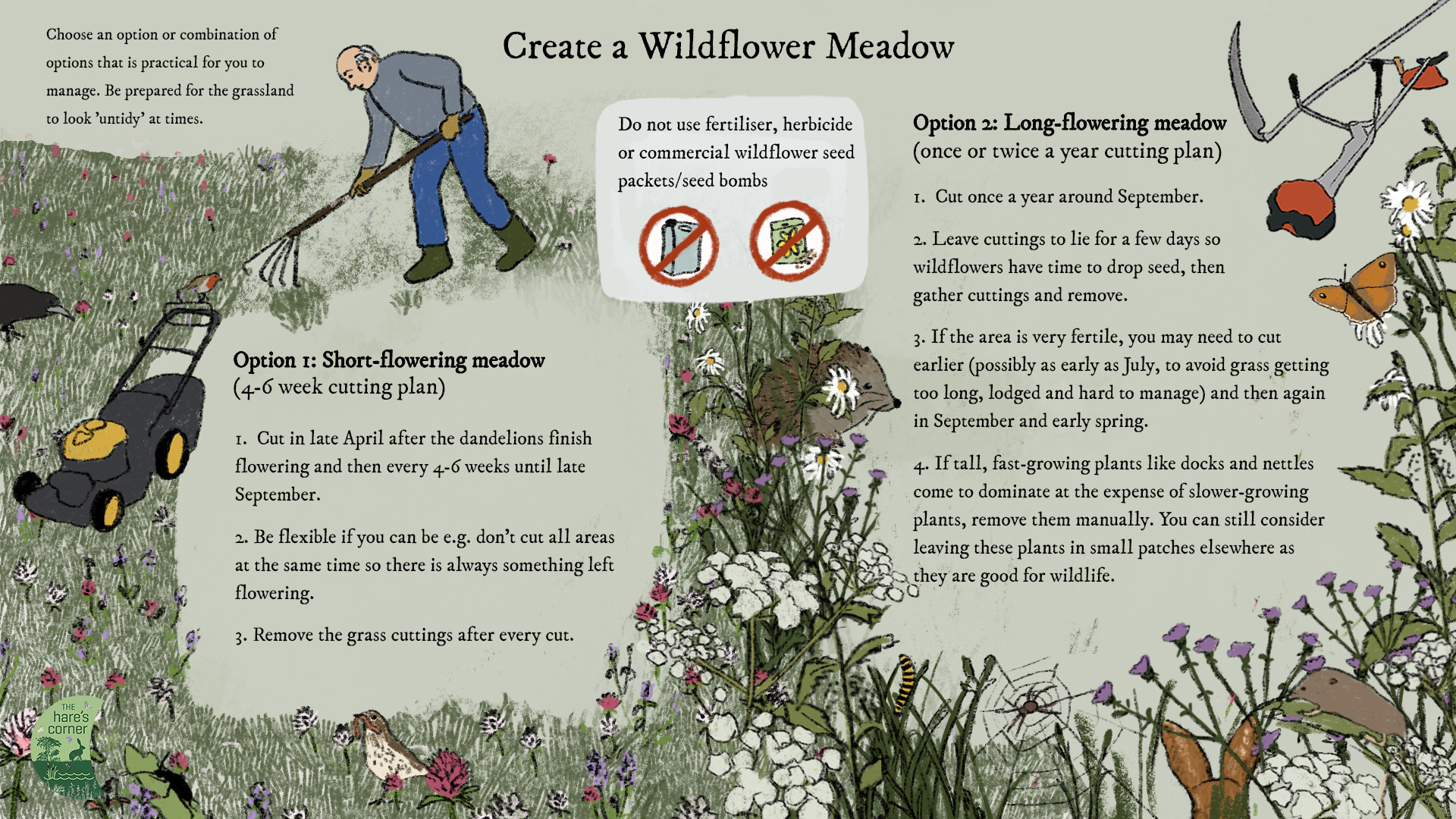
Create a Wildflower Meadow
- Lawns, grassland areas, grassy verges etc.
- Sunny locations with low fertility and free-draining soils are better for meadow creation.
- Target areas where there is already more diversity first – if you aren’t sure, look for areas with a greater variety of leaf shapes – then increase the area over time if manageable.
When: Anytime
How: By cutting your grass to maximise the number and type of plants that get to flower and set seed each year. Sowing commercially available wildflower seeds is not recommended. A better option for nature is to encourage your existing wildflowers and the seedbank in your soil to grow. Wildflower meadows can be managed in many ways. For simplicity two ways are explained below. You can choose one or other or a combination of the two, depending on what is practical for you.
Short-flowering meadow – involves less frequent mowing than the regular mowing style used for a close-cut lawn. This will allow some plants to flower for longer and is relatively easy to manage.
Long-flowering meadow – involves cutting only once or twice a year to allow tall plants to flower and to provide shelter and nesting habitats for many species. This is relatively more complex to manage.
Option1: Short-flowering meadow (4-6 week cutting plan)
- Cut in late April after the dandelions finish flowering and then every 4-6 weeks until late September. Be flexible to maximise the number of flowers e.g. don’t cut all areas at the same time so there is always something left flowering.
- Remove the grass cuttings after every cut to reduce fertility and encourage seedlings to grow.
- Don’t use herbicides, pesticides or fertilizers.
Option 2: Long-flowering meadow (once or twice a year cutting plan)
- Cut once a year around September with a strimmer, scythe or other hand-tools. If using a strimmer, use a cutting blade not the strimmer line as this mulches the cuttings making them hard to remove.
- Leave cuttings to lie for a few days so wildflowers have time to drop seed, then gather cuttings and remove.
- If the area is very fertile, you may need to cut earlier than September (possibly as early as mid-late July, as grass will get long, and hard to manage) and then again in September and early spring.
- If tall, fast-growing plants like docks, nettles, hogweed or ragwort come to dominate at the expense of slower-growing plants, remove them manually (pull or dig out roots). You can still consider leaving these plants in small patches elsewhere as they are good for wildlife.
- Don’t use herbicides, pesticides or fertilizers.
Care for your meadow: Meadows can only exist with correct management. Start with smaller, more manageable areas. Be patient and be prepared for the grassland to look ‘untidy’ at times, especially long-flowering meadows later in the year. Don’t be tempted to cut these too early as you will remove the new flower seeds before they ripen and slow the development of your meadow. Results can take time, 1-3 years if soil is not too fertile and there is a good seedbank, or longer if it is very fertile. However, biodiversity will benefit above and below ground from year one. You can boost the process by sowing locally sourced seeds of Yellow rattle, a semi-parasitic plant that weakens grass growth, and adding seed collected locally from other wildflowers.
Benefits: Flower-rich grasslands are one of the most threatened habitats in Ireland and are extremely important for wildlife – they provide food for insects, birds and small mammals and can store 500% more carbon than fields dominated by one grass species.
Further info
- Meadow-Guideline-2023-WEB.pdf (pollinators.ie)
- Reduced-Mowing-Infographic-WEB.pdf (pollinators.ie)
- Collecting and using wildflower seed – https://pollinators.ie/wp-content/uploads/2022/12/Pollinator-Seeds-How-to-Guide-2022-WEB.pdf
- Zoe Devlin’s ‘Wildflowers of Ireland’
- Jenny Seawright’s ‘Irish Wildflowers’
- Creating and restoring meadows in local communities and gardens – details on short-flowering meadows are on page 11. Or the short flyer Create a short-flowering meadow.
- The Hare’s Corner Clinic – Maintaining your Wildflower Meadow